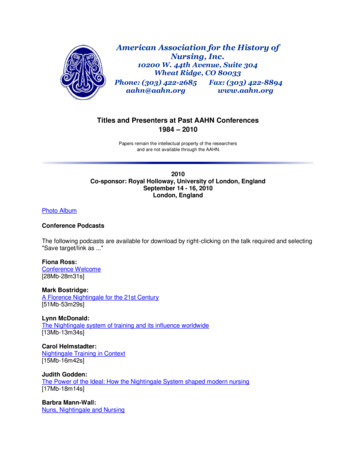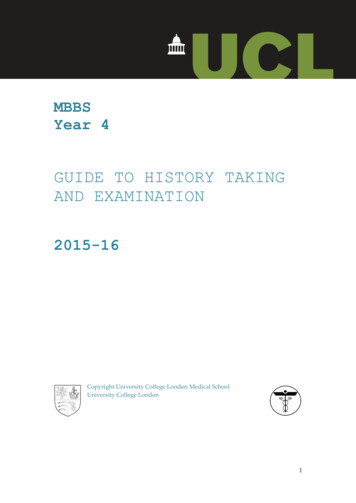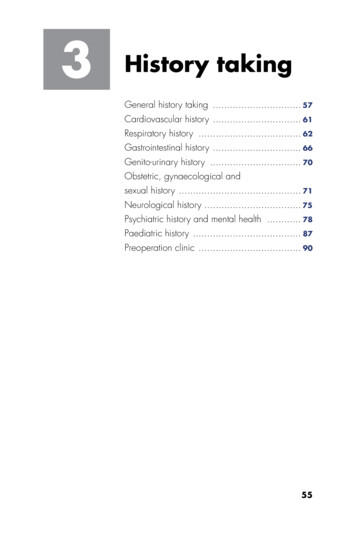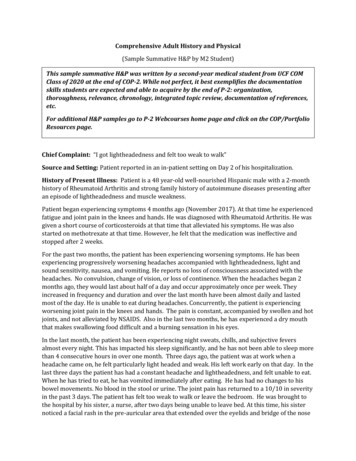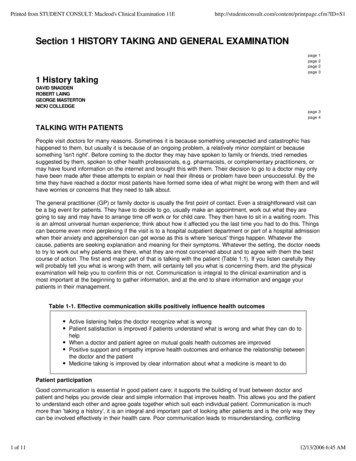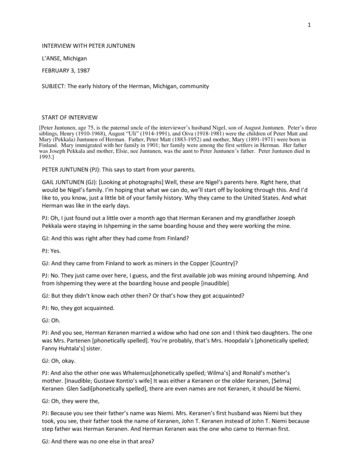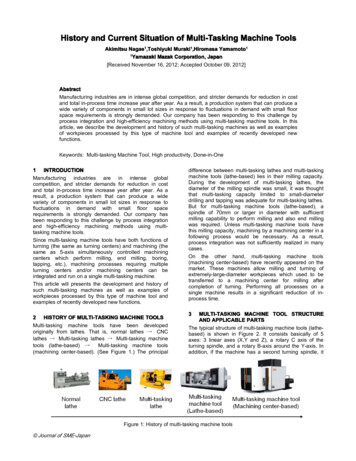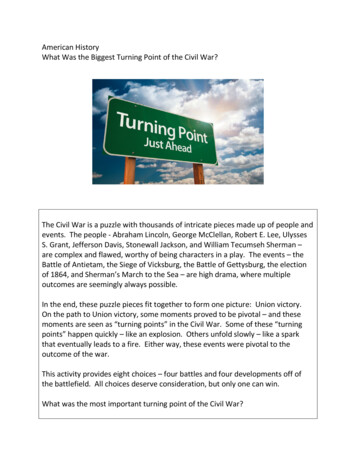
Transcription
American HistoryWhat Was the Biggest Turning Point of the Civil War?The Civil War is a puzzle with thousands of intricate pieces made up of people andevents. The people - Abraham Lincoln, George McClellan, Robert E. Lee, UlyssesS. Grant, Jefferson Davis, Stonewall Jackson, and William Tecumseh Sherman –are complex and flawed, worthy of being characters in a play. The events – theBattle of Antietam, the Siege of Vicksburg, the Battle of Gettysburg, the electionof 1864, and Sherman’s March to the Sea – are high drama, where multipleoutcomes are seemingly always possible.In the end, these puzzle pieces fit together to form one picture: Union victory.On the path to Union victory, some moments proved to be pivotal – and thesemoments are seen as “turning points” in the Civil War. Some of these “turningpoints” happen quickly – like an explosion. Others unfold slowly – like a sparkthat eventually leads to a fire. Either way, these events were pivotal to theoutcome of the war.This activity provides eight choices – four battles and four developments off ofthe battlefield. All choices deserve consideration, but only one can win.What was the most important turning point of the Civil War?
Civil War Timeline1860Nov. 6Lincoln Elected PresidentDec. 20South Carolina Secedes1861Feb. 1Texas Becomes the Seventh State to SecedeFeb. 18Jefferson Davis Appointed the First President of the CSAMarch 4Lincoln Inaugurated as PresidentApril 12Confederate Forces Fire on Fort SumterApril 15Lincoln Calls for 75,000 TroopsApril 17Virginia SecedesJuly 21Battle of Bull RunNov. 8“Trent Affair”1862Jan 1Inflation in the Confederacy Hits 12% per MonthApril 16Confederacy Institutes a Military DraftSept. 17Battle of AntietamSept. 22Lincoln Issues the Preliminary Emancipation ProclamationNov. 7Lincoln Fires McClellan as Leader of the Army of the Potomac
1863Jan. 1Emancipation Proclamation Takes EffectApril 2Richmond, Virginia Food Riots – 5,000 People InvolvedMay 18Siege of Vicksburg BeginsJuly 1-3Battle of GettysburgJuly 4Confederates Surrender at VicksburgJuly 13-16New York City Draft RiotsNov. 19Gettysburg Address1864April 8Senate Passes the 13th AmendmentSept. 1Atlanta Falls to the UnionNov. 8Lincoln Wins Re-ElectionNov. 15Sherman’s March to the Sea BeginsDec. 22Sherman Captures Savannah, GA1865Jan. 31House of Representatives Passes the 13th AmendmentMarch 4Lincoln Inaugurated for a Second Term as PresidentApril 9Lee Surrenders at Appomattox CourthouseApril 14Lincoln Assassinated
Lincoln’s Evolving Views on Slavery and Race-The average human brain weighs three pounds and contains about 100 billion neurons, with over 100trillion connections, creating a complex and dynamic belief system that is unique for each human being.“I hate (slavery) because it deprives our republican example of its just influence in the world,”Abraham Lincoln said during a debate with Stephen Douglas in Peoria, Illinois in 1854. Lincolnwas not just against slavery because of its injustice towards the slaves, but also because itundermined a fledgling democracy. In a later debate in Charleston, Illinois, Lincoln statedsomething very different. “There is a physical difference between the white and black races,”he said. “There must be the position of superior and inferior, and I as much as any other manam in favor of having the superior position assigned to the white race.” While Lincoln wasagainst slavery, he clearly struggled with the issue of equal rights for African-Americans.When he assumed the Presidency in 1861, Lincoln’s goal was to keep the Union together and tokeep slavery from spreading to the west. Midway through the war, Lincoln issued theEmancipation Proclamation. This ended slavery in areas controlled by the Confederacy. By theend of the war, Lincoln was instrumental in passing the 13th Amendment – which ended slaverycompletely. As circumstances changed, Lincoln’s views on slavery adapted and evolved.Lincoln’s views on racial equality are a bit more complex. In the early stages of the war, Lincolnfavored colonization of ex-slaves to Africa or Central America. This is significant becausecolonization was seen as a way to avoid citizenship for African-Americans. However, Lincolnallowed African Americans to fight for the Union in 1864– a move that could be seen aspotentially embracing citizenship for African Americans. In the end, his assassination keeps usfrom knowing exactly what his thoughts were regarding racial equality at the end of the war.Lincoln’s evolving views on slavery and race allowed the Union to morph and change as the warunfolded. Lincoln made it possible for the purpose of the war to change – from a war to keepthe Union together, to a war to end slavery.
Primary Source“My paramount object in this struggle is tosave the Union, and is not either to save or todestroy slavery. If I could save the Unionwithout freeing any slave I would to it, and if Icould save it by freeing all the slaves I woulddo it; and if I could save it by freeing some andleaving others alone I would also do that.What I do about slavery, and the colored race,I do because I believe it helps to save theUnion; and what I forbear, I forbear because Ido not believe it would help to save theUnion ”-Abraham Lincoln – “Letter to HoraceGreeley” – August 22, 1862By the Numbers62: The Emancipation Proclamation sat inLincoln’s desk for 62 days as he waited for aUnion victory in the field. He officiallyreleased it five days after the Battle ofAntietam - on September 22, 1862.Secondary Source“Lincoln was especially careful not to drag theissue of slavery into the war, although it was ahesitation he did not enjoy But Lincoln dared not push that conviction, orthe war, to the point of making it an outrightassault on slavery. For one thing, as herepeatedly acknowledged, he had noconstitutional authority to emancipateslaves Lincoln also had to remember that there werestill four slave states – Delaware, Kentucky,Missouri, and Maryland – that had notseceded from the Union ”-Allen Guelzo – Fateful Lightning – 2012Why Keep It In?Lincoln’s leadership was most important whenit came to the issue of slavery. Hedemonstrated his political genius bysuccessfully dealing with two very differentgroups: Radical Republicans who wantedslavery to end immediately, and Democratswho were against freeing the slaves. Lincoln’sadaptability kept the Union together while theConfederacy eventually ripped apart.13: The 13th Amendment finally ended slavery– but only after a difficult political battle. TheSenate passed the 13th Amendment on April 8,1864, and then the House of Representativespassed it on January 31, 1865. It became lawWhy Vote It Out?when Georgia became the 27th state to ratify iton December 6, 1865 – almost eight monthsThis is way too philosophical. The Civil War isafter Lincoln’s death.about action.
Battle of Antietam-Visitors walk along the “Sunken Road” at the Antietam Battlefield near Sharpsburg, Maryland. Hundredsof Confederate soldiers died in the “Sunken Road” at the Battle of Antietam.In September of 1862, General Robert E. Lee had the Union on their heels.After Union failure during the Peninsula Campaign and Confederate victory at the Second Battleof Bull Run, Lee seemed almost invincible. He thought one more victory might prove to Britainand France that the Confederacy could stand on its own. Confederate hopes for victory in theCivil War rested largely on Britain and France. Through “cotton diplomacy,” the South hoped toforce Britain and France to intervene in the Civil War in order to keep the flow of cotton comingfrom the South to the textile mills of Europe.Lee set his sights on Maryland – a slave state that had stayed loyal to the Union. He had anelaborate plan for the Maryland campaign that called for splitting his army into several smallergroups. This strategy had worked extremely well for him in the past, confusing Union leadersinto inaction. What ensued at Antietam was the single bloodiest day of the Civil War. Therewere over 23,000 casualties in twelve hours of fighting at Antietam – a number that dwarfs the6,600 U.S. casualties on D-Day during World War II.After the two armies fought to a stalemate on September 21, Lee waited for another Unionattack on September 22. It never happened. The Confederates retreated back to Virginia thenext day. McClellan claimed victory, but did not pursue Lee’s retreating Army of NorthernVirginia. McClellan was fired a short time later by President Lincoln.
Primary SourceSecondary Source“Antietam was victory enough to allow Lincolnto issue the Emancipation Proclamation -“The Dead of Antietam” – AlexanderGardiner took photos two days afterthe battle, and these photos went ondisplay at Matthew Brady’s studio inNew York City a month later.The Proclamation profoundly altered thecharacter of the war by linking restoration ofthe Union with the destruction of slavery. Theprospects for a compromise settlement,always doubtful, were now eliminated, since aUnion victory would entail destruction of thesocial fabric of the South.”-Richard Slotkin – The Long Road toAntietam - 2012By the NumbersWhy Keep It In?2 to 1: The approximate advantage McClellanhad over Lee regarding the number of soldiersavailable to each of them. The Union hadabout 75,000 soldiers - the Confederates hadabout 38,000.The victory at Antietam directly led to theEmancipation Proclamation, which completelychanged the war. After Antietam, slaveryseemed doomed. Although Great Britaincontinued to monitor the war – this was theclosest they ever came to recognizing theConfederacy. After the EmancipationProclamation, British recognition of theConfederacy was unlikely.3: The battle is typically broken up into threeiconic parts: the Cornfield, the Sunken Lane,and Burnside’s Bridge.191: A Confederate soldier lost a copy ofLee’s “Special Orders 191.” These ordersdetailed Lee’s plans for the campaign. Theyended up in the hands of General GeorgeMcClellan, the commander of the Army of thePotomac.Why Vote It Out?The Union did not deliver a knockout blow –the war continued for almost three moreyears. Besides, wasn’t Gettysburg the moreimportant Confederate invasion of the North?
Election of 1864-Election flag for Abraham Lincoln (1864)For most of 1864, it looked like President Lincoln would be voted out of office.Lincoln faced Democratic opposition from the beginning of the war – and they would say theyhad reason to oppose Lincoln. During the opening days of the Civil War, Lincoln suspendedhabeas corpus. This meant the federal government could jail suspected southern sympathizerswithout charging them with a crime. Democrats claimed this was proof that Lincoln wasabusing his power. During the midterm election of 1862, Republicans lost twenty-three seatsto Democrats in the House of Representatives. Democratic Congressman ClementVallandigham of Ohio openly called for a negotiated end to the war.Lincoln even faced a division in his own party. A member of Lincoln’s own cabinet – SalmanChase - openly sought the Republican nomination for President himself. Chase was a strongabolitionist who felt like Lincoln’s policies regarding slavery were not strong enough. Lincoln’sopponent in 1864 was George McClellan – the same George McClellan who enjoyed the rabidsupport of his troops while leading the Army of the Potomac. Lincoln had fired him from thatpost in 1862. To top it off, history was not on Lincoln’s side. After Andrew Jackson was reelected in 1832, eight consecutive Presidents – beginning with Martin Van Buren and endingwith James Buchanan - had failed to be re-elected.The Presidential election of 1864 was highly contested and focused on one issue - the directionof the Union war effort. Should the Union fight the war to the bitter end, or should the Unionnegotiate an end to the war and make concessions to the South?
Primary Source“This morning, as for some days past, it seemsexceedingly probable that this Administrationwill not be re-elected. Then it will be my dutyto co-operate with the President elect, as tosave the Union between the election and theinauguration ”-President Abraham Lincoln – “BlindMemorandum” – August 23, 1864By the Numbers47: John Fremont was the last Republicanchallenger to withdraw from the race – andthat happened only 47 days before theelection. Until then, not only was Lincoln’s reelection very much in doubt – his renomination by the Republican Party was inquestion as well.212-21: That was the final count in theElectoral College – a landslide win for Lincoln.475,000: That is the number of residents ofOhio, Indiana and Illinois that had been bornin the South. 40% of residents of those threestates had either been born in the South orhad parents who had been born in the South.How they would vote was very much in doubt.Secondary Source“The election held in the middle of (the CivilWar) became the first democratic canvassever successfully carried out during a civil waranywhere, at any time. It was an election inwhich the issue was what kind of nation thiswas going to be – unified, however painfully,without slavery; or permanently divided withor without it. That was the way Americans ofthat time - North and South – viewed it. Andthat made it perhaps the most critical electionin our history.”-John C. Waugh – Reelecting Lincoln:The Battle for the 1864 Presidency 1997Why Keep It In?The North had many advantages over theSouth – in population, in factories, and inrailroads – but the only way that would makea difference was if the Union was united. By1864, was the Union its own biggest enemy?Was a lack of support for the war the biggestthreat to Union victory? Was the election of1864 a final victory over internal dissent?Why Vote It Out?Even if the election was in doubt for most of1864, it ended up being a blowout. And, themain reason Lincoln won re-election wasbecause of a victory on the battlefield – in thiscase, the Union victory at Atlanta. Lincoln’spolitical victory was tied to military victories.
Battle of Gettysburg-About 1.5 million people from around the world visit the Gettysburg Battlefield every year, making it themost visited Civil War battlefield. A few of them also visit General Pickett’s Buffet – an eatingestablishment located just next to the battlefield in Gettysburg.In May of 1863, Robert E. Lee met with Confederate President Jefferson Davis and proposed asecond invasion of the North. Davis and his cabinet approved Lee’s plans, and set in motion aseries of events that culminated in the most intense battle American soil has ever seen.After losses at Shiloh and Corinth, the war was turning against the Confederacy in the west.The Confederacy needed a victory in the east to take pressure off of its armies in the west, butthere were other reasons to attack. Union leadership was in turmoil. On June 28, GeneralGeorge Mead was summoned by his superiors in the Union Army, and he thought he might begetting fired. Instead, he was promoted and put in charge of the Army of the Potomac just daysbefore the Battle of Gettysburg. European intervention was still a possibility. There would beBritish observers at Gettysburg. Provisions were running low on the home front, and inflationwas spiking. Plus, Lee’s daring tactics had led to major victories during the Peninsula Campaign,Second Bull Run, and at Chancellorsville. It had nearly led to victory at Antietam. A secondinvasion would put Lee on Northern soil once again – attacking both Union armies and morale.What ensued at Gettysburg is a part of our national heritage. The names a part of our nationalDNA: Big Round Top, Little Round Top, Culp’s Hill, the Devil’s Den, the Peach Orchard,Cemetery Ridge, Colonel Joshua Chamberlain, General George Pickett, and the GettysburgAddress. In the end, the Union won a major victory at Gettysburg while Lee and his armyescaped to Virginia to fight another day. The war would continue for almost two more years.
Primary Source“I do not believe you appreciate themagnitude of the misfortune involved in Lee’sescape. He was within your easy grasp, and tohave closed upon him would, in connectionwith our other late successes, have ended thewar. As it is, the war will be prolongedindefinitely ”-President Lincoln – Letter to GeneralGeorge Meade – July 14, 1863By the Numbers0 – This was the number of times theConfederacy invaded the North after theBattle of Gettysburg.10 – That is how many roads lead intoGettysburg – a town with a population ofapproximately 2,000 people in 1863. Theseten roads contributed to the complexity of thebattle – and this complexity made manyoutcomes possible.164,000 – This was the number of soldiersinvolved in the battle – 93,000 for the Unionand 71,000 for the Confederacy. Only six U.S.cities had a larger population than that in1860: New York, Philadelphia, Brooklyn,Baltimore, Boston and New Orleans.Secondary Source“The Northern public were growing weary ofthe war, and a peace movement that wouldhave granted the South independence wasgrowing, fueled in large part by two majordefeats to the Army of the Potomac, atFredericksburg in December 1862 andChancellorsville in May 1863. Lee and hisArmy of Northern Virginia appearedinvincible ”-D. Scott Hartwig – Chief Historian atGettysburg Military Park – 2013Why Keep It In?The Confederacy was closer to winning atGettysburg than you might think. Only thequick thinking of General Winfield Hancockkept the Confederacy from gaining the keyhigh ground on day one. While Pickett’sCharge looks like a suicide mission today,frontal assaults like that had worked in thepast – a good example being a frontal assaultconducted by the Union at the Battle of PeaRidge earlier in the Civil War.Why Vote It Out?Gettysburg might be the best known choice –but that doesn’t mean it’s the most important.Besides – wasn’t Antietam the more importantConfederate invasion of the North?
The Siege of Vicksburg-The “Shirley House” – also known to troops at the time as “The White House” - is the only surviving CivilWar era structure at Vicksburg Military Park. In front of the “Shirley House” are “bombproofs” – bunkersand tunnels where the citizens of Vicksburg and Confederate soldiers sought protection from Unionartillery during the siege.Vicksburg, Mississippi is perhaps the best example of how geography affected the Civil War.On a prominent bluff overlooking the Mississippi River, Vicksburg sits at a spot where theMississippi River curves in a manner that gives whoever controls that spot a clear view of theriver for miles in both directions. Needless to say, Vicksburg was an important city during theCivil War. Whoever controlled Vicksburg controlled the movement of troops and war materialsup and down the Mississippi River.In June of 1863, the Union had control of the entire Mississippi River – except for Vicksburg. Itproved to be a difficult city for the Union to conquer. After many months of frustration,General Ulysses S. Grant executed an elaborate move and ordered Union troops to cross to thewestern side of the Mississippi River and march south of Vicksburg before crossing the riveragain. At that point, Grant then marched toward Jackson, the capital of Mississippi. Aftertaking Jackson, Grant march west toward Vicksburg, where he put the city under siege fornearly two months.Vicksburg fell to the Union on July 4, 1863 – one day after the Battle of Gettysburg ended giving the Union complete control of the Mississippi River.
Primary Source“They have fought as if the very life of theConfederacy turned upon the issue there; andit was the foreboding that this issue must goagainst them that excited that desperationwhich impelled the reckless dash of LEE intoPennsylvania. No man has understood betterthan JEFF. DAVIS, whose own home is on thebanks of the Mississippi, that the power whichholds that ‘inland sea,’ as Mr. CALHOUNtermed it, ruled the continent ”-Secondary Source“The capture of Vicksburg was the mostimportant northern strategic victory of thewar, perhaps meriting Grant’s later assertionthat ‘the fate of the Confederacy was sealedwhen Vicksburg fell.’”-James McPherson – Battle Cry ofFreedom - 1988New York Times - July 8, 1863By the Numbers2: The Union victory at Vicksburg essentiallysplit the Confederacy into two parts – withTexas, Louisiana and Arkansas isolated in thewest, away from Mississippi, Alabama,Georgia, Florida, South Carolina, NorthCarolina, Tennessee and Virginia.47: This is the number of days the siege ofVicksburg lasted.1907: Citizens of Vicksburg reportedly did notcelebrate the Fourth of July until 1907.29,495: That was the number of Confederatetroops that surrendered to Union forces atVicksburg on July 4, 1863. By comparison,General Lee led 71,000 Confederate troopsinto battle at Gettysburg.Why Keep It In?Battles in the east get a lot of attention, butvictory in the west made victory in the eastpossible for the Union. The fall of Vicksburgmade it possible for the Union to surround theConfederacy and devote more manpower andfirepower to battles in the east.Why Vote It Out?The number of troops in the west pales incomparison to the number of troops in theeast. Plus, the Confederacy was closest togaining independence at Antietam orGettysburg. The war was decided in the eastbecause that is where Lee took calculated risksand attempted to win the war in 1862 and1863 – and failed.
Sherman’s March to the Sea-The focus of Sherman’s March was to destroy the Confederacy’s capacity to make war. Railroads were amajor target for Sherman. Here, a Union solider stands beside one of “Sherman’s Neckties.” These werepieces of railway that were heated over a bonfire and twisted around a tree. This rendered the rail lineunusable.Taking a Union army and marching right through the heart of the Confederacy without supplylines? The idea was almost absurd.This was precisely what General William Tecumseh Sherman proposed to General Grant afterAtlanta fell to the Union in July of 1864. The idea of “Total War” – targeting anything that couldbe used to support the war effort of the Confederacy - was hatched. His goal was to “makeGeorgia howl.” Sherman left Atlanta on November 15 and emerged at Savannah, Georgia alittle over a month later.Many of Sherman’s targets were civilian, in the form of grain, cotton and livestock. His armylived off of the land along the way. Surprisingly, Sherman spared the beautiful city of Savannah.However, after reaching Savannah, he turned north and marched through South Carolina,heading toward its capital city of Columbia. Sherman’s troops destroyed much of the state thathad initially led the secession movement.Sherman’s March was a strike at the heart of the Confederacy – a strike that was largelyunopposed, and a strike that made it obvious that by the end of 1864, the Confederacy wascrumbling. The Civil War would never be the same.
Primary Source“ I hastened back to my frightened servantsand told them that they had better hide, andthen went back to the gate to claim protectionand a guard. But like demons they rush in!My yards are full. To my smoke-house, mydairy, kitchen, and cellar, like famished wolvesthey come, breaking locks and whatever is inmy way. The thousand pounds of meat in mysmoke-house is gone in a twinkling ”-Dolly Sumner Lunt – “A Woman’sWartime Journal – An Account of thePassage Over a Georgia Plantation ofSherman’s Army on the March to theSea” – November 19, 1864Secondary Source“Sherman’s march across Georgia delivered afatal body blow to the Confederacy. Themarch to the sea finished off what was left ofthe shorter regional rail lines in Georgia andmade it almost impossible to keep Lee’s armyin Virginia supplied with food and ammunitionfrom the granaries and factories of the lowerSouth.”Allen Guelzo, Professor at Gettysburg College Fateful Lightning - 2012By the NumbersWhy Keep It In?37: That is the number of days that it took forSherman’s army to march from Atlanta toSavannah, Georgia – where they couldestablish communication with Union forcesagain through the Union navy.Emotion and practicality. This campaign wasall about inflicting psychological terror on theentire Confederate population and making itimpossible for the Confederacy to support itsarmy. And, if a country can’t stop an opposingforce from marching right through the middleof it, how can it survive?285: The march lasted 285 miles, and thewidth of the destruction ranged from 20 to 60miles along the way.60,000: This was the number of Union troopson Sherman’s March. By comparison, theentire Confederate Army numbered about200,000 in January of 1865.Why Vote It Out?Sherman’s March is flashy, but the outcome ofthe Civil War had been decided by this point.Maybe it was more decisive in shortening thewar rather than actually winning the war?
Internal Conflicts in the Confederacy-Gutzon Borglum – most famous for his work at Mount Rushmore – began the Confederate Memorial atStone Mountain, Georgia in the 1920’s. Located just thirty minutes northeast of Atlanta and completed in1972, the memorial features Jefferson Davis, Robert E. Lee, and Stonewall Jackson. The carving is 76 feettall, 158 feet wide, and extends 42 feet into the mountain. By contrast, George Washington’s head atMount Rushmore is about 60 feet tall.From December 20, 1860 until June 8, 1861 – beginning with South Carolina and ending withTennessee - eleven states seceded from the United States. At the time, they stated that one ofthe reasons they did this was to escape the control of a strong central government. They feltthat the federal government was either abusing its power or was getting ready to abuse itspower. They viewed themselves as an oppressed people. They compared secession to theAmerican Revolution. In the beginning, many people in the South viewed the war as a“romantic adventure” - famously depicted in the ballroom scene from the movie Gone With theWind, where Southerners danced and celebrated secession. After the Battle of Bull Run, therewas a lot to celebrate.In order to fight the Civil War, the Confederate States of America took two controversialactions: they taxed their citizens, and they instituted a military draft. From the way theycultivated the land to the way that they worshipped, the Southern way of life was based uponthe action of the individual rather than the individual being a part of a group. Moreover, whenSoutherners did identify with a group – it was with their state, more so than with theConfederate States of America. Assessing taxes and instituting a military draft are the actions ofa strong central government. As the war progressed, states were less and less willing to meetthe demands of this central government.As the war unfolded, these internal problems became an anchor for the Confederacy. Thesame spirit of individualism that inspired secession eventually help lead to its destruction.
Primary Source“It seems military men are assuming thewhole powers of government to themselves I had therefore concluded to take no notice ofthis matter till the meeting of the legislaturewhen I expect to ask the representatives ofthe people to define the bounds to which theydesire the Governor to go in the defense ofthe rights and sovereignty of the state ”-Governor Joseph E. Brown (Georgia) –Letter to Alexander Stephens, VicePresident of the Confederate States ofAmerica – September 1, 1862Secondary Source“State governors frustrated the exemptionprocess by claiming more state officers thanthey needed and by obstructing theconscription process. The classic example wasGeorgia’s Governor Joe Brown, who exemptedmore men than any other governor and foughtconscription (the draft) in the courts.President Davis wrote Brown extended letters– actually legal briefs – and in November of1862 sent former interim Secretary of StateWilliam M. Browne on a diplomatic mission toseek the compliance of the Georgia governor.The state Supreme Court in Georgia upheldthe draft unanimously; still Brown persistedand withheld troops whenever possible.”-By the Numbers0: That was the number of political parties inthe Confederacy. There was no rival politicalparty to organize dissent. This led to aConfederacy that was increasingly fractured.5%: The Confederacy was only able to raiseabout 5% of its revenue to pay for the warfrom taxes. The rest had to be borrowed.9,000%: During the war, prices rose in theSouth by more than 9,000%. This runawayinflation was the result of the Confederacyborrowing and printing money to fund the wareffort.Emory M. Thomas – The ConfederateNation (1979)Why Keep It In?In order to fight the war, the Confederategovernment had to exert control over thestates. In doing so, they violated the veryprinciples upon which they claimed it wasfounded: states’ rights. That contradictionmeant the Confederacy was doomed.Why Vote It Out?The Confederacy was able to work throughthese problems for at least two or three years.Continued victories in the field would havealleviated this problem.
New York City Draft Riots-An engraving from the August 1, 1863 edition of Harper’s Magazine, with a caption that read “Charge ofthe Police on the Rioters at the Tribune Office.” Other engravings in the issue portray a drugstore beingransacked, a dead soldier being dragged through the streets, and an African-American being lynchedduring the riots in New York City.In July of 1863, the citizens of New York City literally tore their city apart.The immediate cause of the riot was the newly instituted military draft – and more precisely,the provision that allowed wealthy individuals to pay 300 to buy their way out of mandatorymilitary service. There were other factors that contributed to the violence. In 1860,approximately 47% of New York City was born in other countries – a large jump from only 8.7%being foreign-born in 1830. Many of these immigrants resented the idea of fighting for thefreedom of African-Americans, only to potentially have their jobs taken away or their wagessuppressed by these newly freed
were over 23,000 casualties in twelve hours of fighting at Antietam – a number that dwarfs the 6,600 U.S. casualties on D-Day during World War II. After the two armies fought to
